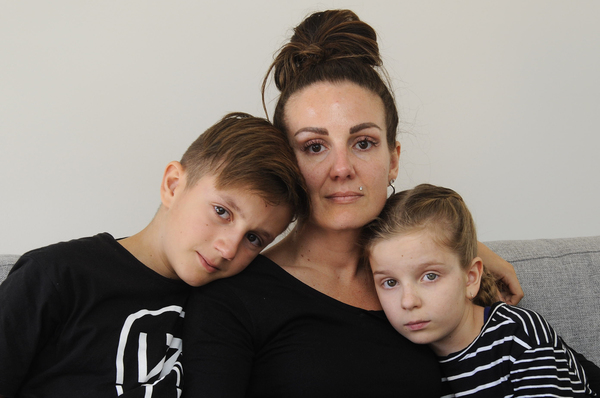
By Bonny Burrows
After years of debilitating pain, Officer mother Shauna Cahill is now free of the toxic mesh which was once killing her.
The 35-year-old mother-of-two last month underwent surgery to remove the mesh, which had left her with constant excruciating groin, vaginal and pelvic pain.
The surgery, the fifth attempt to remove the toxic material which is banned in Scotland due to its side-effects and is now the subject of an Australian Federal Court class action, was successful.
The mesh was inserted in 2015 as part of a simple surgery to treat her pelvic organ prolapse (POP) – a common condition affecting one in three women post-childbirth, defined by bladder incontinence.
The procedure, which involves a hysterectomy, bowel and bladder prolapse repair and sling insertion, was supposed to stop the incontinence but instead, due to the insertion of the transvaginal mesh, almost cost Ms Cahill her life.
The material began to slowly erode away her organs – a side-effect medical professionals allegedly know of but “keep quiet” she says – and Ms Cahill was left in excruciating daily pain which she described as a seven or eight out of 10 on a good day.
It took two years and five surgeries, during which Ms Cahill, her partner, and their two children Mak and Suni suffered emotionally and physically, for the material to be removed from Ms Cahill’s body.
To the family’s relief, the five-hour surgery on 19 July was successful; however it hasn’t come without further challenges.
Speaking post-procedure on 10 August, Ms Cahill said the operation took twice as long as expected due to the difficulty of removing the mesh.
“The surgeon’s words were there’s hard, there’s difficult, there’s extremely difficult, there’s extremely extremely difficult and then there was you,” Ms Cahill said.
Ms Cahill said post-op, her battle was far from over.
She is fighting an infection which has intensified the pain, and may have some irreversible nerve damage in her groin.
The young mum is also still wheelchair-bound when heading outside the house and her incontinence has worsened to the point she can “stand and be wet through and I won’t have even realised”.
“Living with mesh is difficult to explain and even now that I’ve had removal my life has been forever changed,” Ms Cahill said.
“However, I’m thankful that the mesh is completely gone and can no longer leach toxins into my body or cause any further damage inside of me,” Ms Cahill said.
“Too exhausted” to fight the legal system, Ms Cahill is not a part of the class action against pharmaceutical giant and mesh supplier Johnson and Johnson.
Instead, she is documenting her journey on the Facebook page Shauna’s Best Chance.
Ms Cahill told the Gazette in May that if one person was spared the pain of such surgery, then in a way, her battle was OK.
“It’s s*** right now but everything happens for a reason,” Ms Cahill said.
“This has happened to me, but it does not need to happen to anyone else.”
Shine Lawyers, the firm behind the lawsuit which commenced in July, believe as many as 8000 Australian women have been impacted by life-altering symptoms after surgery’s similar to Ms Cahill’s, with at least 700 having used Johnson and Johnson mesh products.
Despite her strength during the difficult time, Ms Cahill acknowledged she wouldn’t have made it through without the support of her friends and family.
“To those of my friends who have been here for me, supported me and continued to make an effort even though some days I’m not much company, I will be forever grateful,” Ms Cahill said.
Ms Cahill’s Facebook page, documenting her journey, can be found at: www.facebook.com/gofundmeShaunasbestchance
Hearings on the Johnson and Johnson lawsuit are expected to run for about six months.







